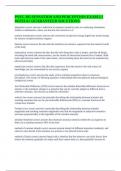Exam (elaborations)
PSYC 305 SENSATION AND PERCEPTION EXAM 1 || WITH A+ GUARANTEED SOLUTIONS.
- Course
- Institution
adaptation correct answers a reduction in response caused by prior or continuing stimulation. Similar to habituation, where you become less sensitive to it sensory transduction correct answers the conversion of physical energy (light) into neural energy by sensory receptors (sensory organs) d...
[Show more]



